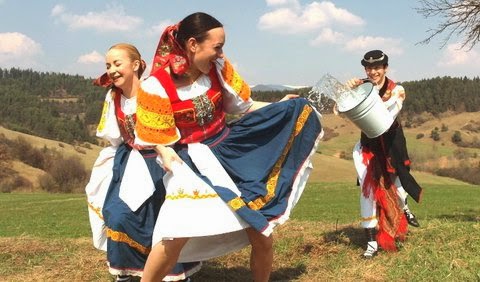Pasg hapus - Happy Easter or go dance and get whipped day
 |
| I have two dads! |
Maypole
festivals – United Kingdom
These date back to when the British people
were pagans (That's before Christ came to the party)
and worshiped the gods that ruled over nature. Easter was celebrated back then
but under a different guise – the start of spring. This marked the return of life as plants grew and flowered, and Maypole
dancing was performed to show the cycle that life took through the seasons.
The dance consists of a large pole with ribbons and streamers draped off the
top. People then wind the streamers around the pole in a series of overlapping
waltz-like moves until the entire pole is wrapped up.
Penance
Processions - Spain
These - very bizzare -
marches take place throughout Spanish towns and cities to mark Holy Week - the
last week of Lent, attracting tourists from around the world. The 'penance
processions' through the streets are performed by Catholic religious
brotherhoods who wear different coloured robes to tell themselves apart. They
also don conical hoods for the haunting processions as they carry life-size
effigies of Jesus Christ and the Virgin Mary accompanied by dramatic drum beats
and mournful music. Traditionally these hoods maintained their anonymity. It is
still an annual event throughout Spain and many who take part walk barefoot
while others have shackled feet as penance. Others carry ceremonial candles or
wooden crosses.
Halloween and Easter Meet - Finland
 |
| Too cute to be evil. |
Children in this Scandinavian country go begging in the streets with sooty faces and scarves around their heads, carrying broomsticks, coffeepots and bunches of willow twigs. In some parts of Western Finland, people burn bonfires on Easter Sunday, a Nordic tradition stemming from the belief that the flames ward off witches who fly around on brooms between Good Friday and Easter Sunday. But these days they show up as young girls who go door to door with pots of coffee and try to ward of evil spirits.
Morris
dancing – United Kingdom
Morris dancing is largely
similar to Maypole festivals but a lot more commonplace. Morris dancing is done to demonstrate
the return of spring and life starting over again after winter. The first mention of the dance is the 1500s but most believe it's actually an ancient pagan tradition. There are still active communities that view the
celebrations as a way of life rather than just attractions for tourists. They
are mainly concentrated around the Cornish peninsula, but can be found all over
the UK. Wow, not my culture but kind of cool all the same. I can hear the Safety Dance in my head...
Getting Whipped and Wet - Slovakia
 |
| Nope - not questionable behavior at all. |
You
wouldn't want to be a woman over the Easter weekend in Slovakia, or Hungary, or other slavic places that....whip women with willow branches and doused in water, but it's all
good fun and actually performed with the aim of making women more beautiful and
healthy. The folk custom, once believed to purify the soul and body, predates
Christianity, which arrived in Slovakia in the ninth century but became
intertwined with Easter traditions.
Check out other ones here at the top ten Unique Easter Traditions blog. Happy Feasting!

No comments:
Post a Comment